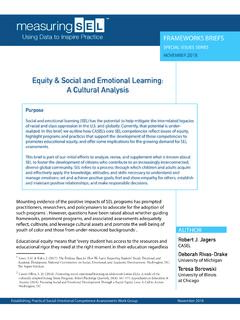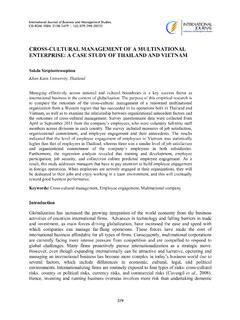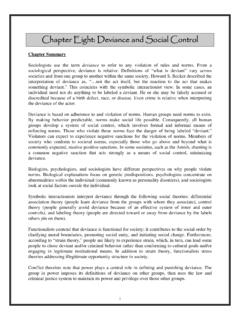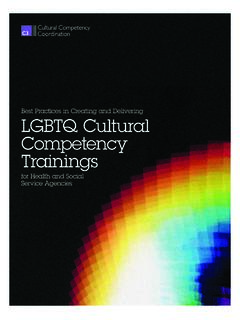Transcription of TECHNICAL NOTE ON GENDER NORMS - UNICEF
1 TECHNICAL NOTE ON GENDER NORMS1 TECHNICAL NOTE ON GENDER NORMSThe United Nations Population Fund (UNFPA) and United Nations Children s Fund ( UNICEF ) Global Programme to End Child Marriage (the Global Programme ) works with many partners to advocate for and support practical actions to end child marriage and promote GENDER equality and the empowerment of adolescent girls. This TECHNICAL note builds on the TECHNICAL note on GENDER -transformative approaches,1 promotes a common understanding of key concepts, and provides practical guidance on how to promote change in GENDER NORMS . The TECHNICAL note is written in simple and succinct language. However, further reading of references in the endnote and the TECHNICAL note on GENDER -transformative approaches is highly recommended for a better understanding of concepts and programming strategies.
2 This note is evidence based and informed by promising practices from the Global Programme and its partners and collaborators. DEFINING CONCEPTS AND APPROACHESWhat are GENDER NORMS ? GENDER NORMS are a subset of social NORMS that relate specifically to GENDER differences. 2 They are informal, deeply entrenched and widely held beliefs about GENDER roles, power relations, standards or expectations that govern human behaviours and practices in a particular social context and at a particular time. They are ideas or rules about how girls and boys and women and men are expected to be and to act. People internalize and learn these rules early in GENDER NORMS sustain a hierarchy of power and privilege that typically favours what is considered male or masculine over that which is female or feminine, reinforcing a systemic inequality that undermines the rights of women and girls and restricts opportunity for women, men, and GENDER minorities to express their authentic selves.
3 4 Changing restrictive GENDER normsLike with all social NORMS , it requires sustained effort and time to change GENDER NORMS . GENDER NORMS are resistant to change because they are pervasive and largely invisible, considered normal , and are held in place by a web of behaviours, beliefs and The TECHNICAL note on GENDER -transformative approaches6 considers how these approaches examine, question and change rigid GENDER NORMS . GENDER transformation aspires to tackle the root causes of GENDER inequality. It moves beyond individual self-improvement among girls and women towards redressing the power dynamics and structures that serve to reinforce gendered NORMS and child marriageChild marriage is perpetuated by GENDER NORMS that prescribe when and why adolescent girls and boys should marry.
4 Child marriage is not a norm itself but a practice that is embedded in a web of GENDER NORMS , beliefs and other factors. Many of these GENDER NORMS are reflected in social institutions such as labour markets and legal Figure 1 presents examples of the kinds of GENDER NORMS , beliefs and factors that may influence child marriage, demonstrating how complex it is to identify and address the NORMS , beliefs and factors supporting child marriage. HOW TO TRANSFORM GENDER NORMS IN CHILD MARRIAGE PROGRAMMINGG ender-transformative approaches are central to the design and delivery of Phase II of the Global In contrast, most other child marriage programmes focus narrowly on preventing child marriage rather than (more ambitiously) aiming to change underlying GENDER of developing programmes to promote the change of GENDER norms12 Involve and consult community groups and other stakeholders in all steps of the following process: 1 Map and assess the GENDER NORMS , beliefs and factors surrounding child marriage in a country or location.
5 Start with existing Based on the mapping, select a package of context-appropriate interventions that address the most important GENDER NORMS , beliefs and factors related to child Use the socio-ecological model to situate the Continuously monitor changes and adapt programming accordingly with the view of making sustained AND PURPOSE The purpose of this TECHNICAL note is:1 To facilitate the exchange of knowledge and good practices to promote change in GENDER NORMS 2 To provide practical guidance on the application of key concepts and effective programming approaches TECHNICAL NOTE ON GENDER NORMS2 Beliefs about marriage as key route to social and economic protectionBeliefs about women s role in society as wives and mothers Beliefs about the importance of female sexual purity Beliefs that parents and elders have prime authority over children s life trajectoriesA responsible parent should ensure their daughter is married by early adulthoodTo become a woman a girl should marrySex should only take place within heterosexual marriageGirls should be virgins before marriageA girl should obey her parents over timing/choice of marriage partner A girl
6 Shouldmarry young13 Most girls marry by 18 yearsLack of opportunities for women and girls in societyLegal systems that do not set or enforce, or allow exceptions to a minimum marriage age of 18 Economic systems that place greater economic value on males than femalesBroad influencing factorsBeliefs influencing normsNorms influencing child marriageNorms on child marriageFIGURE 1: Child marriage is held in place by a web of GENDER NORMS , beliefs and factors (indicative)9 KEY POINTS:14 Transforming GENDER NORMS is complex and requires multi-sectoral approaches across the socio-ecological model. Changing GENDER NORMS may take generations and cannot be achieved by a single programme. An adolescent sexual reproductive health GENDER NORMS approach explores three levels of structural interventions at the macro, meso and micro levels.
7 Macro-level structural changes in institutions and resources are in fact primary drivers bringing about sustained norm Example: In South Korea, reforms in labor laws and employment opportunities for women throughout the 1990s were a key driver in eventually shifting NORMS around son preference. Meso level interventions such as working with the district education system to increase female teachers in upper grades can concurrently improve the quality of learning, expand comprehensive sexuality education, and provide positive role models for Concerted and complementary efforts at the micro level such as integrating life skills or parental education programs within the school system or fine-tuning of cash transfer programs to maximize access by intended beneficiaries can raise the scale and sustainability of such Efforts to change GENDER NORMS and power relations can have unexpected consequences.
8 New ideas and practices are often contested and can lead to resistance or a backlash. Engaging respectfully with all community groups can reduce resistance to change. GENDER NORMS can change as a result of deliberate efforts to encourage change, including new laws, policies or programmes, and social and political : Margaret Greene, Rachel Marcus, Rachel George (ALIGN) TECHNICAL NOTE ON GENDER NORMS3 EVIDENCE-BASED EXAMPLES OF GENDER -TRANSFORMATIVE INTERVENTIONSThis section provides examples of how GENDER transformation can be promoted across the socio-ecological It is important that interventions at different levels complement and reinforce each other with the aim of implementing them jointly. 1 Policies and legislation Key messages: Identify the laws and policies that have to change to promote positive GENDER NORMS and Support women in leadership positions to bring about GENDER -transformative policy change at all Consult and engage sensitively with all stakeholders and develop context-specific strategies for legislative reform processes to pre-empt Mitigate unintended consequences of law 2 Economic incentives and education Key messages.
9 Girls education backed by economic incentives has had positive outcomes in delaying child Cash transfers can be an effective tool for postponing the marriage of adolescent girls, but are not sufficient to change GENDER NORMS around child Complementary programming should offer vocational and financial skills training for adolescents. Cash alone may have the unintended consequence of reinforcing a norm of compulsory marriage at age social and behavioural change communication with communities and through mass media Key messages: social and behavioural change communication can play an important role when implemented with other interventions, but will not change behaviours and GENDER NORMS on its own. They need to be linked to systems and services. Edutainment via television series, films, radio dramas and interactive theatre is a promising strategy to challenge NORMS relating to child from social and behavioural change communication aimed at changing GENDER NORMS in Ethiopia:29 Participatory and reflective community-based dialogues using mixed methods are effective.
10 Uptake of messages has been highest where girls and their families have actionable options. Top-down messaging is not effective. Parents do not want to be told how to raise their children or to feel that their cultural traditions are considered to be backward. Where risks are exaggerated and emphasise worst-case scenarios, communities are less likely to Partner with men and boys31 Key messages: Working with men and boys is key to changing harmful GENDER Address men and boys in their specific roles as child or adult grooms and fathers of child Interventions must be aligned with and support interventions with women and & Legal Mechanisms In Amhara, Ethiopia, some girls use legal mechanisms to refuse child The attempt to reform family law in Mali is an example of what not to do.


















